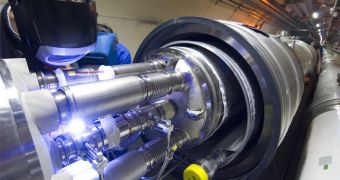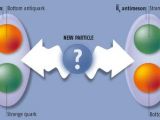Where is all that strange substance we now call antimatter? Theory predicts that, in the first few seconds of the universe, matter and antimatter were found in roughly the same proportion, but somehow most of the antimatter was annihilated during interactions with matter. These annihilation processes eventually left behind a larger amount of matter in the universe, but something else must have taken place in order for this to happen. If only annihilation processes would have driven the destruction of antimatter, then these interactions should have left no matter behind, just radiation.
Now physicists believe they are on the verge of finding the answer for this long standing mystery. On the other hand, these new findings could finally topple the shaky Standard Model, the theory which describes all the fundamental particles in the universe, their nature and interactions. The answer may lie in one of the fundamental forces governing the laws of the universe, namely the weak nuclear force, which, according to physicists, does not have the same effects on antimatter as those experienced with ordinary matter.
CP violation
In particle physics, this asymmetry is called CP violation and it could have allowed matter to survive in a greater proportion than antimatter, to create the universe as we know it today. The problem is that the Standard Model is not capable to create the whole picture of the universe, thus to clearly explain the CP violation. Alternatively, physicists proposed the existence of extra spatial dimensions - up to 7 unseen dimensions may (or may not) exist -, supersymmetry, or even forces that we are not yet aware of. New elementary particles, not yet discovered, may also play an important role in solving the mystery of the antimatter.
One of these new particles is the Bs meson, which is composed of one bottom anti-quark and a strange quark - quarks being the elementary particles that compose the fermion family of particles such as protons, neutrons and so on. The Bs meson presents scientific interest, mostly because it is one of the few particles which shifts into its own antiparticle and back more than 3 trillion times each second before decaying into other particles. It is widely believed that a unobserved particle determines this oscillation; finding it would most likely resolve, at least partially, the CP violation.
Currently studying the CP violation observed in Bs mesons, two groups of scientists are running the CDF and D-Zero experiments at the Tevatron particle accelerator at Fermilab. By colliding protons with their antiparticles, the antiprotons, physicists are able to create Bs mesons. With each collision, they learn a little more about the CP violation that stretches beyond the powers of the Standard Model.
Data uncertainties are too large
Giovanni Punzi of University of Pisa, one of the physicists running the CDF experiment, reveals that the experimental uncertainties are simply too large to make a definitive claim. On the other hand, Luca Silvestrini from Italy's National Institute of Nuclear Physics was able to reduce some of the uncertainties in the data to show that CP violation is much stronger than previously believed.
Combining the CDF and D-zero experiments showed that there is a 99.7 percent probability that CP violation is real, but it is not clear yet what kind of experiment would be able to explain the data they are gathering.
"It is tantalizingly interesting at the moment. If it is true, it is earth-shattering," says Val Gibson of University of Cambridge, one of the experts into B meson physics and CP violation. Jacobo Konigsberg calls for caution, as the data still requires statistical analysis to rule out even the slightest uncertainty. Konigsberg is the leader of the CDF experiment. "Researchers are 'cautiously excited' about the work but more date needs to be analyzed to rule out a fluke," he said. In addition to the CDF and D-Zero experiments, the Large Hadron Collider is expected to start preliminary tests this year. The LHC is currently the most powerful particles accelerator in the world, specially constructed to study mesons that contain bottom quarks.

 14 DAY TRIAL //
14 DAY TRIAL // 
